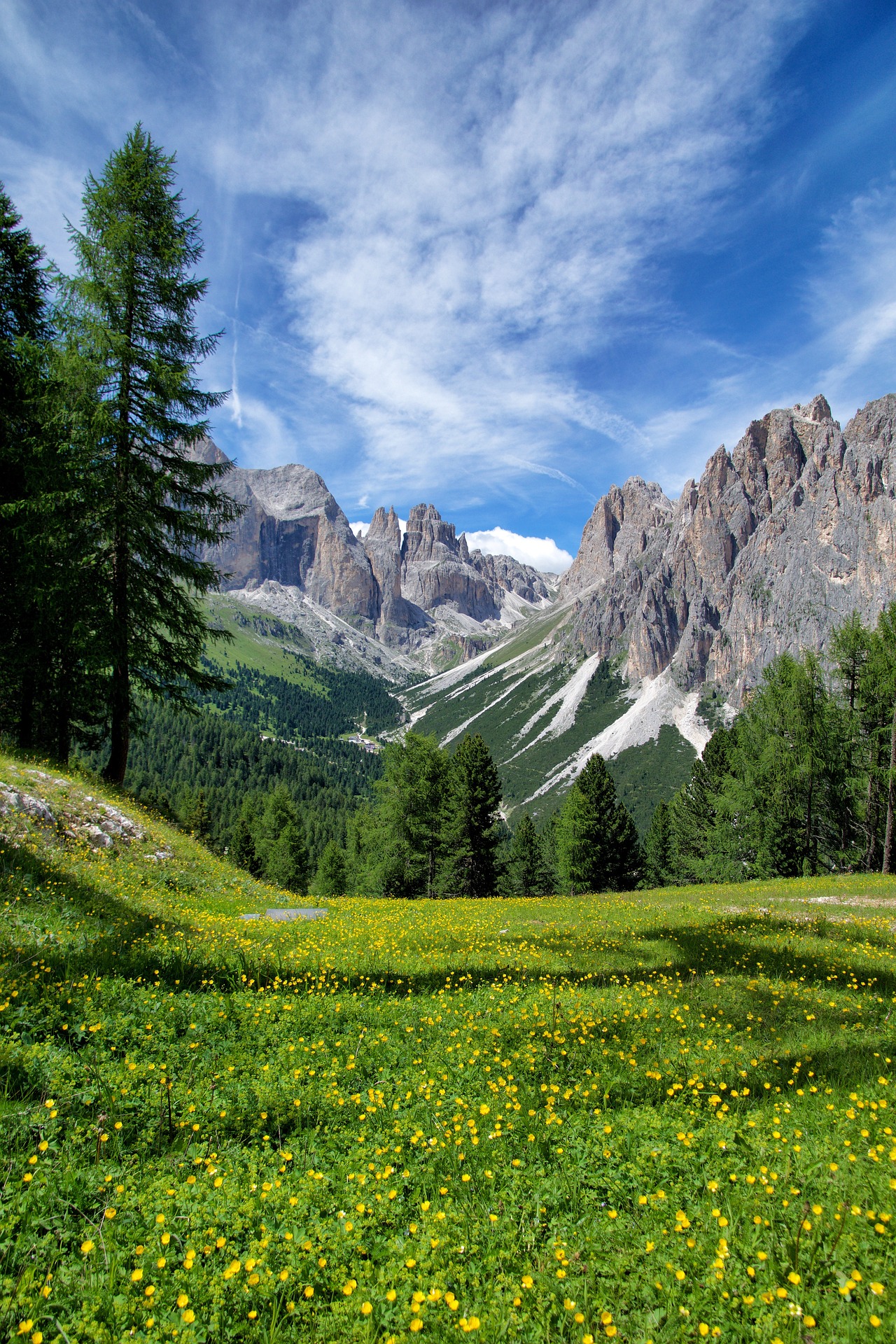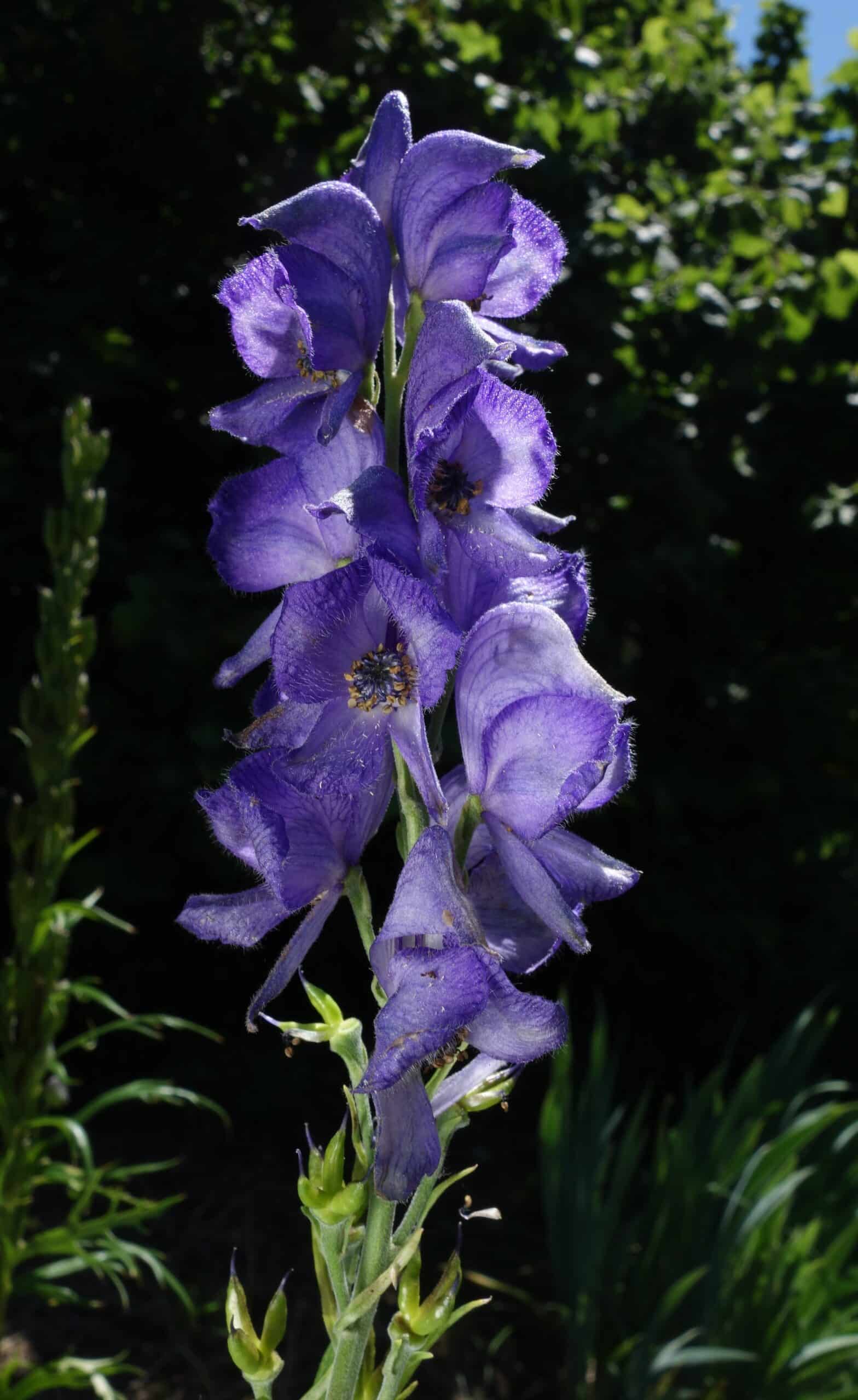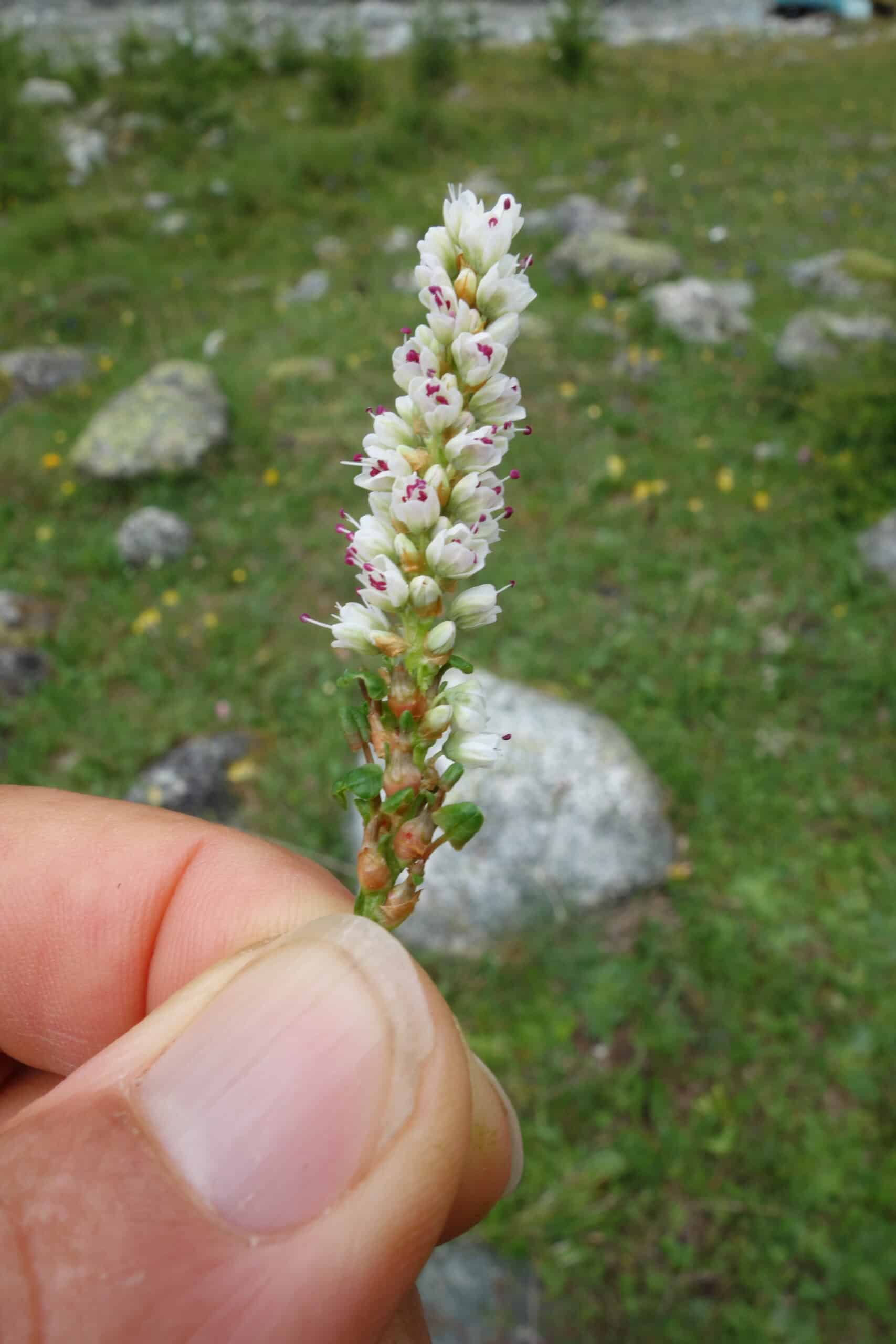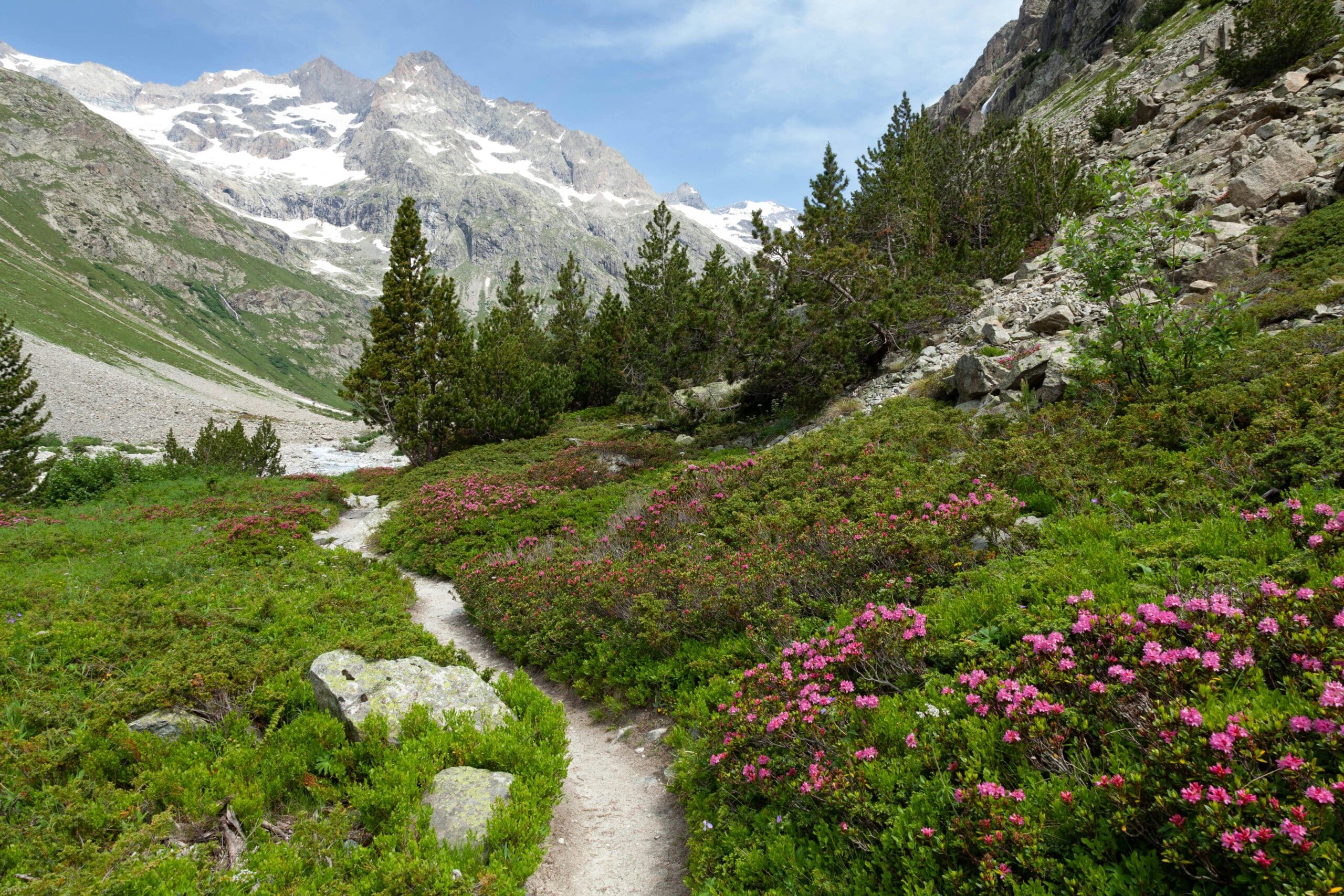
Climbing the Alps is like travelling north. An ascent of one hundred metres corresponds to a horizontal distance of one hundred kilometers. So, from the foot of the mountains to their summit, we see the same changes in vegetation as when we head for Scandinavia. Botanists distinguish, from bottom to top, several “vegetation stages”, five of which are characteristic of the Alpine chain. Oaks and hornbeams dominate the collinean level, at its lowest point. The montane level is home to beech and fir. In the subalpine zone, depending on humidity, spruce, larch or hooked pine thrive, followed at the top by alder and finally rhododendron, where the forest limit was once artificially lowered to develop pastures. The alpine level is home to lawns studded with brightly colored flowers during the brief summer months. Finally, on the craggy rocks of the nival zone, a few species manage to survive despite the extreme conditions. Mountain woods and meadows abound with plants to pick and enjoy.
In mountain meadows

At altitudes of over a thousand meters, caraway abounds in meadows. In the same family as the carrot[1]with its finely divided leaves in linear segments abruptly terminated by a small point. The white flowers cluster at the top of the stems in compound umbels with uneven rays.
The aromatic root of the caraway (mountain carrot) used to be eaten before the flowering stem. And the “tops” are a good vegetable. But it’s the aromatic seeds that have made it famous.
A typical northern European condiment, caraway is used to flavor sauerkraut, bread(Pumpernickel), munster and gouda – it is often sold as “Dutch caraway”. In German, it’s called Kümmel and is distilled into an alcohol of the same name. It aids digestion, expels gas from the intestine and promotes milk secretion in breast-feeding women.
The beans are usually used dry, but should be tasted fresh. Their flavor is powerful, with lovely citrus notes. Other fragrant creations include a sauce that works wonders with orange salad and a tasty aspic. The seeds are easy to pick before ripening, but they fall as soon as they reach this stage.
Caraway is often referred to as “meadow cumin”, leading to confusion with true cumin, which is ubiquitous in Arab and Indian cuisine. The difference requires a little attention: caraway seeds are slightly curved and brownish, with a pungent, penetrating aroma; cumin seeds are straight and greenish, with a warm, sweet aroma.
The Dutch claim that eating caraway sharpens the memory and helps pass exams. Its seeds are said to help artists find inspiration. In days gone by, a caraway plant in the garden acted as a private detective: if a woman had gone to find her lover, the plant would suddenly lose its flowering umbels and its stiffened stems would all point in the direction of the place where the guilty lovemaking had taken place…
| Fresh caraway fruit aspic with carrots – Cook fresh caraway seeds in water with a chopped onion and sliced carrots. Season with salt. – When the carrots are tender but still crunchy, remove and set aside. – Blend the liquid, filter and add agar-agar powder (4 g per liter, diluted in a little cold water). – Boil for 2 minutes, stirring constantly. – Add more caraway, blend and leave to stand for 5 minutes in a warm place. – Pour some of the liquid into the bottom of a cake tin and chill in the fridge (you can place a few leaves or flowers in the bottom of the tin for decoration). – Once set, arrange the carrots, pour in the remaining liquid and chill. – Unmould and cut into slices. |
If you’re unlucky enough to twist your foot while hiking in the Alps, chances are the remedy is right around the corner.Arnica colonies dot sub-alpine meadows on acidic soil in yellow. They resemble large daisies with golden-orange flower heads, composed of a core of tube-shaped florets and a crown of tongues, all the same warm color. They give off an aromatic scent and sting the tongue when tasted.
Arnica has a long history of use: its medicinal properties were already mentioned by Hildegarde de Bingen in the 12th century. The famous tincture is prepared by macerating the flowers in 60° alcohol. A specific remedy for external trauma without wounds, it is applied as compresses against blows, sprains and strains. It should be diluted in water, as pure tincture is irritating.
The plant still needs to be recognized with certainty. Look for a rosette of four broad, cross-shaped leaves at the base of the stem. With their pronounced veins, they resemble yellow gentian leaves. In the past, they were smoked under the name of “Vosges tobacco”. The stem bears two small, opposite leaves at the top. These features unambiguously distinguish arnica from its cousins, the doronics, with their alternate greyish-green leaves.
Arnica flowers are not without toxicity. Medical literature reports burning, nausea or convulsions following ingestion to stimulate the circulatory and nervous systems. Flower powder makes you sneeze.
Thank you, cows!

Nitrogen-rich areas are home to a luxuriant nitrophilous flora. The edges of alpine chalets and resting places, abundantly smoked by cattle, are sure to be home to the trio of alpine dock, stinging nettle and goosefoot. These three excellent wild vegetables were once the summer delight of cowherds.
Alpine dock or “monk’s rhubarb” forms vast beds of large green leaves with long, red-striped petioles, and tall stems crowned with opulent brown bunches. Its thick petioles, sometimes as big as your thumb, are juicy and tangy. Like rhubarb, they can be sliced and prepared in compotes and pies, as well as savoury dishes such as gratins, quiches and ramekins (recipe). Simply suck on them as they are for their refreshing flavor.
The nickname “monk’s rhubarb” recalls the use of its large root, rich in anthraquinones, as a laxative: this is how rhubarb was used, in the past more renowned in medicine than in gastronomy.
When the young leaves emerge from the ground in early mountain spring, they are so tender they can be eaten as a salad. The mature, dark-green leaves are eaten like spinach. They were used in chalet soups, with milk and cheese. They were preserved for the winter by lacto-fermenting like sauerkraut. Once Alpine dock was no longer eaten, it was fed to animals for a while, then simply forgotten… Yet it’s an excellent vegetable, not bitter in the slightest, unlike its tannin-laden congeners from the plains. And it’s easy to gather huge quantities, given its size and abundance. But dock contains soluble oxalates and, like spinach, should be eaten in moderation if you’re prone to stones and rheumatism.
| Alpine dock petiole ramekins – Carefully peel the petioles and cut into 2 cm-long pieces. – Brown them quickly in a frying pan. – Arrange the petiole sections in glass or porcelain ramekins. – Prepare a “royale” by beating three whole eggs with 1 L milk, salt, pepper and paprika. Prepare a “royale” by beating 3 whole eggs with 1 l milk, salt, pepper and paprika. – Pour over the petioles in each ramekin. – Bake in a bain-marie for 40 min at 190°C. – Serve hot. |

Our region’s worst killer, themonkshood, lives in tight rows in nitrogen-rich mountain meadows. Everything about it is striking. Its tall, rigid stem bears numerous leaves, deeply divided into narrow lobes starting from the same point. Its large, dark-blue flowers, gathered at the top of the stems in long, dense clusters, are shaped like a Greek helmet, hence the nickname “Jupiter’s helmet”. Its beauty makes it a popular choice for gardens. But beware…
Wolfsbane is the most toxic plant in our flora. Ingestion of a single leaf or a few flowers causes nervous, visual and cardiac disorders, the outcome of which can be fatal. Simply picking the plant causes dermatitis, or even intoxication if the juice enters the body through abrasions on the fingers. The Celts poisoned their war arrows with wolfsbane sap – making them unsuitable for hunting, as the game became inconsumable.
Many people have been poisoned by confusing their roots with… turnips. Indeed, monkshood grows from a spindle-shaped root: napellus means “little turnip” in Latin. Fleshy and easy to dig up, it has sometimes tempted the unwary to make it their last meal. Particularly rich in alkaloids, a few grams can kill an adult.
Poison, remedy… the line is blurred: aconite tincture is used medicinally, in minute doses, against pain and as a cough sedative. Homeopathy is a more reliable way of harnessing its virtues: “aconitum” is recommended against cold snaps, the onset of colds and fever accompanied by chills.
Four other species grow in France, all in the mountains. Wolfsbane has violet-blue flowers, variegated wolfsbane has blue and white flowers, and poisonous wolfsbane has yellow flowers. All are dangerous. Wolfsbane, with its yellow flowers and common on limestone, is less dangerous.
Foisonnement at the water’s edge
Along the torrents that tirelessly carve out the Alpine valleys, in the heat of midsummer, there’s an ambiguous scent, heavy and wild. Depending on one’s temperament, these wet jungle whiffs are either pleasing or repulsive. They come from the immense colonies of butterbur.

Their enormous leaves have earned them the nickname “devil’s hats”. They make effective headgear for protection from excessive sun or stormy showers. In spring, large clusters of “flowers[2] In spring, large clusters of upright pink “flowers” emerge directly from the ground, without a single leaf to be seen. These only deign to come up after the downy balls of blossom, resembling a multitude of miniature dandelions. Shy at first, they quickly grow to an imposing size, sometimes over a metre high and almost as wide, which is enough to identify them. Their mass covers the banks of the torrents with a veritable virgin forest where young explorers can lose themselves.
Their size and thick stalk are reminiscent of rhubarb, but unfortunately the taste of butterbur leaves much to be desired. It’s reminiscent of artichokes, but with a nauseating whiff. You could cook the plant in several waters and make gratins with it. But it’s hardly worth the effort.
In Japan, however, the young inflorescences of a related species, the “fuki”, are consumed with passion. The young leafy shoots are then preserved in salt or soy sauce. Finally, the leaves and stalks are peeled and cooked in soup or as a vegetable.
Woods and forests
The slopes of the Northern Alps appear to be clad in majestic fir forests that make city dwellers dream… but these often turn out to be nothing more than sadspruce plantations. No matter!
Up close and from a distance, the differences between these two conifers are easy to see. The trunk of the spruce is reddish-brown[3] and its hanging branches form wide draperies. Fir trunks are light grey[4] with large resin blisters when young. Its twigs are spread out in superimposed planes and rise towards the top of the tree. Spruce needles are sharp and worn all around the twig like a swab. Their short stalks remain clearly visible on dry twigs. Diamond-shaped in cross-section, they roll between the fingers. Fir needles are flat and rounded, decorated with two white stripes on the underside and arranged in a plane like the teeth of a comb. They leave a circular scar when removed from the branch. Spruce cones hang from the branches and fall whole to the ground, while fir cones are upright and fall apart as they ripen, scale by scale. So, if you see cones on the ground, they must be those of a spruce.
The fir tree, from the Gallic sappo[5] – vuargno in Savoyard -, is mountainous, meaning it grows alongside beech. The spruce or “pesse” (from the Latin picea, “pitch”), on the other hand, normally grows at higher altitudes, in the sub-alpine zone. Since the 17th century, however, it has been planted much lower down in distressing monocultures, or “spruce stands”, where nothing grows except a few brambles that the lack of light prevents from producing fruit…
Firs and spruces are among the tallest trees in Europe: in the Carpathian mountains, some of them, some 800 years old, are over 60 m tall. The young shoots of both are edible. All tender, light green against dark foliage, they appear in early spring. The best are the lemon-flavored spruce.[6]. They are added to spring salads, where they replace vinegar. Aromatic and tangy, they are an excellent seasoning for fish. They are also used to make sauces, syrups and fragrant sorbets. Fir bud syrup” is actually made from spruce shoots. Fir shoots smell distinctly orange. Despite their bitterness, they can be used in the same way as their cousin.
Conifer foliage is rich in vitamin C. In 1535, Jacques Cartier’s crew, suffering from scurvy, was saved by spruce needle tea.[7] given to him by the Iroquois of Canada. Spruce needles also have expectorant properties, and are used for lung problems.
It’s essential to know how to distinguish fir leaves from the poisonous yew leaves, which are flat without white stripes on the reverse.
| Spruce sorbet – Coarsely chop the spruce shoots and arrange in three equal heaps. – Bring 1 l water to the boil with 200 g sugar and add the first heap. – After a quarter of an hour, remove from the heat and add the second heap. Cover. – A quarter of an hour later, when the liquid has become lukewarm, add the third heap and blend for a long time with an immersion blender. – Filter carefully through a fine sieve. – Turbinate in an ice-cream maker. – When the ice cream begins to set, add an egg white and leave to turbinate for a further 10 minutes to soften the texture of the sorbet. |
When you look at all the maple trees in our mountain forests, you can’t help but dream of their famous syrup. Their sap is slightly sweet and used to be extracted to make a tangy drink by letting it ferment in the air. But that’s not enough to make syrup… They lack sugar. In order for the sap to be sufficiently loaded with sucrose, it is necessary that, as it rises at the end of winter, very cold nights follow warm, sunny days. This is the case in the northeastern United States and eastern Canada, whereas our springs are too mild and rainy.
Maples are easily recognized by their opposite branches and five-lobed leaves with fan-shaped veins. Their fruits are winged samaras that fall from the tree like tiny helicopters. Two related species can be found in our mountains: the plane maple and the sycamore maple.
The young leaves of maple trees can be eaten raw or cooked when they are still quite tender. Young fruits were sometimes preserved in vinegar.

Deep in the woods, often beneath spruce trees, the ground is strewn with small, pale-green, three-leafed leaves that could easily be mistaken for clover. Each leaf has a long pink stalk and three lobes shaped like an inverted heart, indented at the top. When tasted, a delicate acidity invades the mouth. These are the leaves of thewood oxalis or “cuckoo’s bread”. Their botanical name, Oxalis acetosella, is self-explanatory: it derives from the Greek oxus, meaning “acid”. The epithet is a diminutive of the Latin acetosa, meaning “acid”.
The leaves are pleasant to eat as they are, with their stalks, to quench thirst, and make good additions to salads. They can be used, raw or cooked, like sorrel leaves (p. 000), but their flavor is finer and less aggressive. Macerated in water, they make a pleasant lemonade.
The flowers start at the base of the plant and are solitary on long, spindly stalks. They decorate salads with their five white petals veined with pink.
In moderate quantities, oxalis is refreshing and depurative. But it is rich in oxalic acid: arthritis sufferers, rheumatisers and lithiasis sufferers should avoid consuming it in excess.
Three related species are found in France. One of them, oxalis corniculée, is a common garden “weed”. Its lemony, pseudo-trefoil leaves are also edible. Its yellow flowers produce small, elongated fruits that can be used as a tangy condiment. Pick them while they are still tender, as they quickly harden.
Let’s stay in the mountain woods and pick a few red currants. But we’re in for a surprise: the scarlet, translucent berries of the Alpine gooseberry are perfectly tasteless! That’s not to say they’re bad, but they don’t stimulate the taste buds. Let’s turn to the rock redcurrant, whose acidity is more in line with our expectations. Even before tasting them, the difference is obvious: the large leaves of the rock currant reach 10 cm, while those of the Alpine gooseberry are half that size.

Among the bushes, in open forests and right up to the edge of sub-alpine meadows, the noble acaule carline flourishes. The epithet doesn’t seem very appropriate: “acaule” means “without stem”, whereas this thistle stands proudly at the top of a sturdy stem, its broad flowerhead with silvery bracts. In fact, there are rare shortened specimens whose flowers nestle in the hollow of a rosette of fearsomely thorny leaves. Botanical nomenclature is not an exact science…
Beauty in a plant is not necessarily desirable. Neither is goodness. Carline, endowed with both attributes, has been over-harvested in the past to make bouquets or end up on the plate as an artichoke. Indeed, despite the painful barrier of thorns that must be overcome to access its succulent heart, the budding head was highly prized in days gone by. As a result, carline is now officially protected from over-picking.
Alpine pleasures
We’ve now reached the tree line. Here, in the “battle zone” that marks the boundary between subalpine forests and alpine grasslands, rhododendron bursts into bright pink bloom in early summer. For mountain dwellers, it’s the “rose of the Alps”: rhododendron derives from the Greek rhodon, “rose” and dendron, “tree”. Even outside its blooming season, this bushy shrub remains one of our mountain adornments, with its tough, bright-green evergreen leaves. Rhododendron ferrugineux’s leaves, on the reverse side, have an astonishing rusty color due to a multitude of tiny scales. This species thrives on siliceous soils and only grows in the western part of the Alps. The shaggy rhododendron replaces it in the east and on limestone. Its thinner leaves are edged with long cilia. In France, it can only be found in a few places in Haute Savoie.

Are rhododendrons poisonous? Books claim they are, but some mountain people use the flowers to make jams and jellies, with no apparent harm…
Have you ever heard of “pixie nuts”? That’s what children call the tiny bulblets of viviparous knotweed, barely larger than mustard seeds. Crunchy and sweet-tasting, they are reminiscent of fresh hazelnuts, with a slight astringency. They can be nibbled along the way.
To spot this inconspicuous plant, an adult has to crouch down and look around carefully. There it is, hidden between two weeds: a few long, shiny leaves with curled edges and a single stem topped by an elongated pom-pom of white flowers. Bulbils encircle the stem in a sleeve beneath the flowers. Small red balls topped by a green cap, they ensure the plant’s asexual vegetative reproduction. They germinate, detach and attach themselves to the soil, giving rise to a new seedling, a clone of the mother knotweed.
In the hollow of the rocks
The miracle of life takes on its full meaning in the mountains. Plants have to cope with extreme conditions of cold and drought. Rocks are a particularly thankless environment. Nevertheless, some plants manage to anchor their roots in the crevices. To adapt to the lack of water, succulents swell with liquid. In the Alps, these include sedums and houseleeks, typical members of the Crassulaceae family.[10].
Sedums or “orpins” have fleshy, cylindrical leaves, pointed at the apex and united in terminal sleeves. Some branches are sterile, while others bear upright stalks of white or yellow flowers, depending on the species. The leaves, filled with a tangy juice, are pleasant to eat as they are, despite their astringency. They are refreshing on a walk.
Joubarbes look like little artichokes, and children play greengrocer with these thick, interlocking balls of leaves. In summer, they open up to reveal flowering stems at their center, densely covered with upward-pointing leaves. On alpine rocky outcrops, several species cohabit, for the most part with pink flowers. Large-flowered houseleek is the exception, with its pale yellow color. The spider’s web is so named because its rosettes are covered with long, fine, tangled hairs that capture morning moisture for the plant’s benefit.
The leaves, juicy and tangy but astringent, can be sucked to quench thirst.
Joubarbe derives from Jovis barba, “Jupiter’s beard”. By planting these plants dedicated to the god of thunder on roofs, our ancestors thought they were protecting their homes from lightning. The upright stems are reminiscent of a mini-paratonnerre…
Contemplating houseleek flowers reveals veritable mandalas formed by twelve to fifteen sharp petals and a crown of colorful stamens – a perfect and little-known expression of plant beauty.

Discover our online course designed by François Couplan, an internationally recognized expert in ethnobotany with over 50 years’ experience. With 30 modules, 120 courses and high-quality theoretical instruction complemented by field courses, this unique three-year training program will enable you to become a professional in the uses of plants. Accessible to all, it explores in depth the relationship between man and plants, opening up exciting professional opportunities. Join us to deepen your knowledge, explore the plant world and develop a rewarding relationship with nature.
It was on the limestone cliffs of the Grande Chartreuse that the monks came to seek out thevulnaria. essential for concocting their famous liqueur. This creeping St John’s wort knows how to be discreet. Its slender stem bears two by two small, round leaves like coins. Hence its nickname “penny St John’s wort” or “nummular St John’s wort”, from numma, meaning “coin”. The large yellow flowers, sometimes veined with red, betray its kinship with perforated St. John’s wort (p. 000).
When crumpled, it gives off an aromatic, slightly fruity, slightly balsamic scent, which perfumes the alcohol in which the plant, picked just as it begins to flower, is macerated. This tincture has real wound-healing virtues, but it’s not forbidden to heal the wounds of the soul by enjoying it in moderation. It improves with age…
In Isère, St John’s wort harvesting may be regulated by prefectoral decree.

Another plant goes by the name of “vulnaria”, an anthyllid, a member, like peas and clovers, of the legume family. Common in the mountains, it is easily recognized by its multi-leaved leaves and yellow papilionaceous flowers in dense heads. It is not aromatic.
There’s no evidence that hyssop is also used to make Chartreuse, but it’s certain that in the Vercors region it’s used to make excellent liqueurs. Its flowering tops are also used to make herbal teas to relieve colds, hence its popular nickname of “Alpine tea”.
Several upright stems grow from a thick stump, topped with opposite, elongated, bright-green leaves. The flowers, in short terminal clusters, have a pale yellow, two-lipped corolla. It thrives in rock gardens, preferably on limestone.
The species is protected and can only be picked for personal consumption, within the limit of what a hand can hold. Harvesting always begins with respect for nature.
[1] Umbelliferae.
[2] In fact small flower heads.
[3] It is sometimes called “red fir”.
[4] This is the “white fir”.
[5] From the Indo-European root sap, “sap”, which gave rise to “flavor”. Sap in English means “sap”.
[6] They contain an essence of limonene, like lemon peel.
[7] A local conifer, closely related to fir and spruce.
[8] It belongs to the same family, Ericaceae.
[9] It belongs to the same genus, Vaccinium.
[10] From the Latin crassus, “thick” because their leaves are fleshy.

